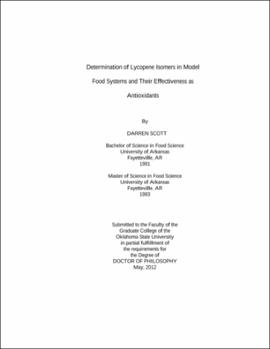| dc.contributor.advisor | McGlynn, William | |
| dc.contributor.author | Scott, Darren | |
| dc.date.accessioned | 2013-11-26T08:22:38Z | |
| dc.date.available | 2013-11-26T08:22:38Z | |
| dc.date.issued | 2012-05 | |
| dc.identifier.uri | https://hdl.handle.net/11244/6620 | |
| dc.description.abstract | Scope and Method of Study: We compared methods of extraction and processing that could be used to develop potential value-added products from watermelon culls and determined the effect of these extraction and processing methods on lycopene concentration, lycopene isomeric form, and final-product antioxidant capacity. | |
| dc.description.abstract | Findings and Conclusions: Unfiltered, macerated watermelon tissue had higher concentrations of lycopene than pressed/ filtered watermelon juice. This was true for both heated and unheated juice and macerate samples. When heated and unheated samples were averaged within treatments, unfiltered, macerated treatments possessed about 109% more lycopene than press/filtered juice treatments. It seems likely that this difference was due to some portion of lycopene being retained in the material used to filter the pressed juice samples. However, additional research is required to quantify this. Treatments alone or in combination had no effect on lycopene isomeric form. Overall, within the parameters tested, maceration appeared to be a better method for maximizing lycopene recovery from culled watermelons than pressing/filtering. Thermal processing of watermelon by boiling watermelon puree until sufficient water was removed by evaporation to render it the consistency of tomato sauce had a measurable effect on lycopene concentration but not on antioxidant activity as measured by the lipophilic Oxygen Radical Absorbance Capacity (ORAC) assay. It also caused the formation of detectable low levels of cis-isomers of lycopene that were not quantified. Neither basic wine-making techniques nor fermentation by Saccharomyces cerevisiae caused a change in the isomeric form of lycopene found in the lees (settled residues) of the finished wine. No antioxidant activity was detected by the lipophilic ORAC assay in the wine. However, antioxidant activity was detected by the hydrophilic ORAC assay. This may have been due to the presence of phenolic compounds, citrulline, or sulfur dioxide in the finished wine. However, no analysis was performed to measure these compounds. Our results indicate that our process is viable for making wine from culled watermelon. | |
| dc.format | application/pdf | |
| dc.language | en_US | |
| dc.rights | Copyright is held by the author who has granted the Oklahoma State University Library the non-exclusive right to share this material in its institutional repository. Contact Digital Library Services at lib-dls@okstate.edu or 405-744-9161 for the permission policy on the use, reproduction or distribution of this material. | |
| dc.title | Determination of lycopene isomers in model food systems and their effectiveness as antioxidants | |
| dc.contributor.committeeMember | Brandenberger, Lynn | |
| dc.contributor.committeeMember | Maness, Niels | |
| dc.contributor.committeeMember | Bowser, Tim | |
| osu.filename | Scott_okstate_0664D_12141.pdf | |
| osu.accesstype | Open Access | |
| dc.type.genre | Dissertation | |
| dc.type.material | Text | |
| dc.subject.keywords | lycopene | |
| dc.subject.keywords | processing | |
| dc.subject.keywords | value-added | |
| dc.subject.keywords | watermelon | |
| dc.subject.keywords | wine | |
| thesis.degree.discipline | Food Science | |
| thesis.degree.grantor | Oklahoma State University | |
